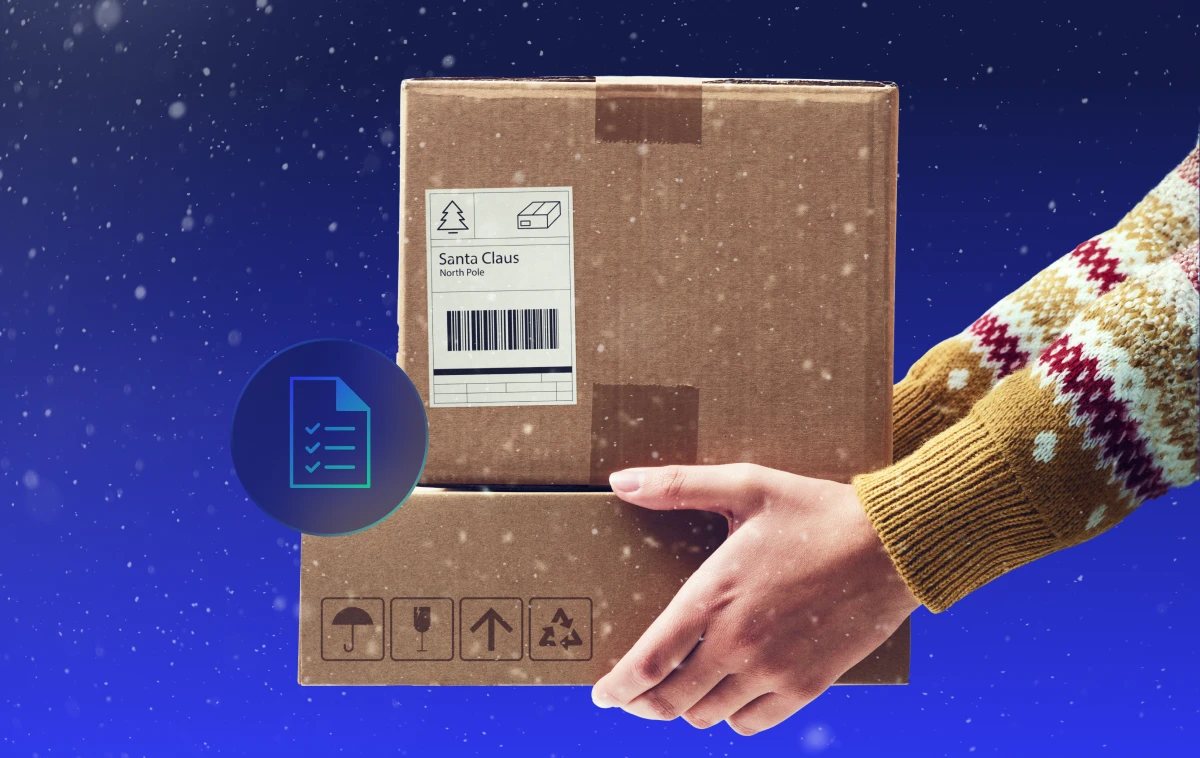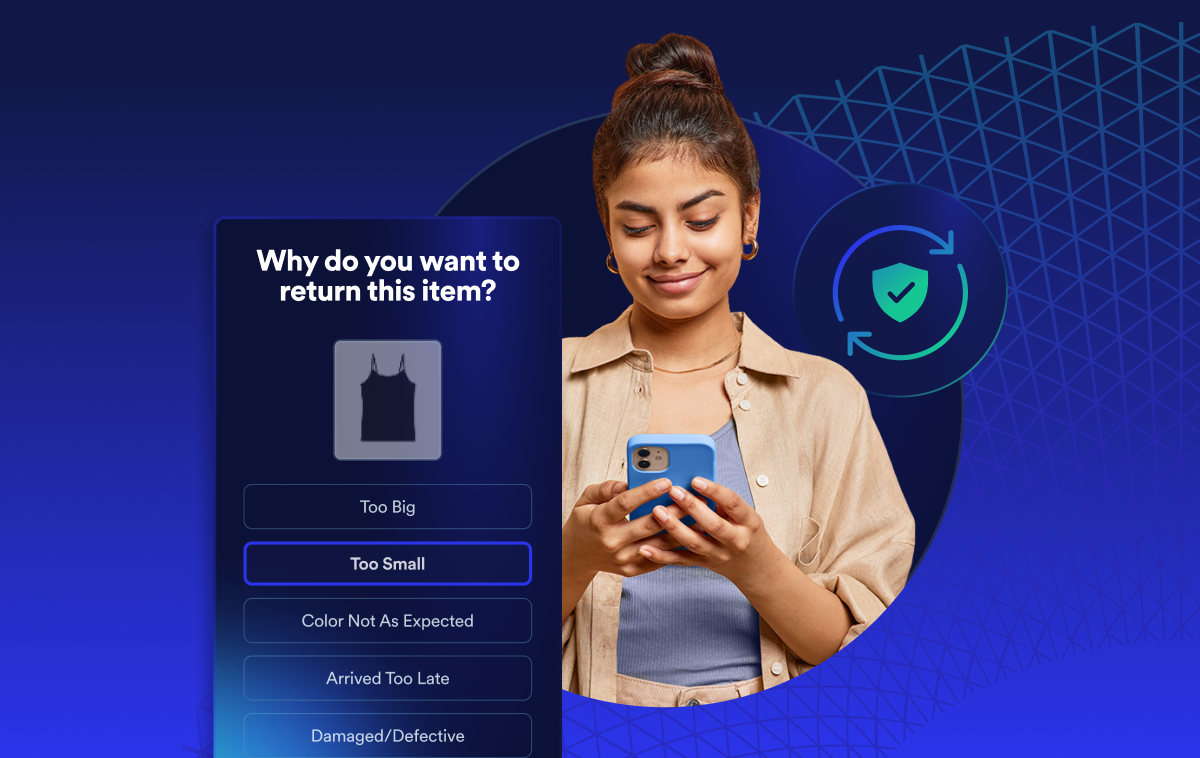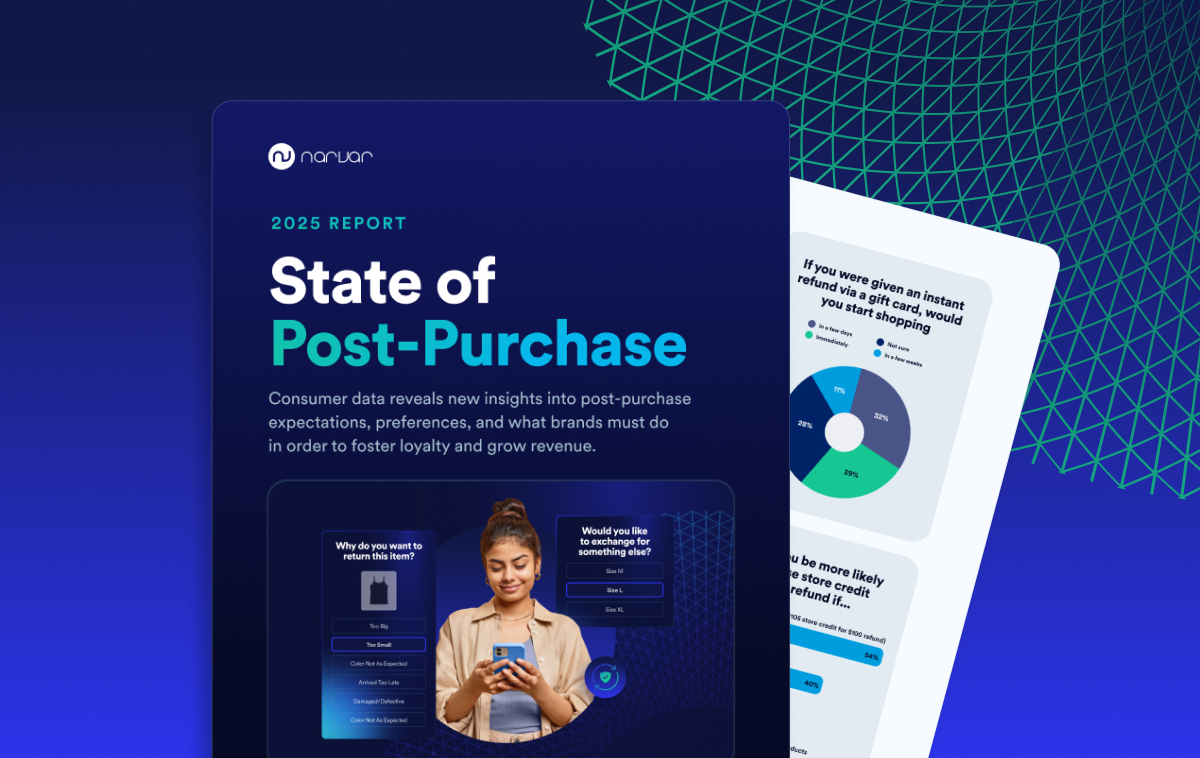
AI-powered delivery date estimates to boost conversion
Give shoppers peace of mind and protect and grow your bottom line
Personalized tracking experiences to build brand loyalty
Returns and exchanges management to mitigate fraud and reward best customers
Proactive communication to drive customer lifetime value
Delivery claim management to tackle fraud and build trust
Grinch-Proof, Scrooge-Savvy: Protect Your Margins Post-Purchase

How retailers can turn post-purchase from a margin risk into a holiday growth engine.
Imagine the holidays as a blockbuster crossover event: The Grinch vs. Scrooge.
On one side, the Grinch is swiping packages off doorsteps, causing delivery chaos and costly claim disputes. On the other, Scrooge is so focused on pinching pennies that support teams are understaffed, refunds bleed profits, and frustrated shoppers take their business elsewhere.
Left unchecked, these two villains tag-team your bottom line. The Grinch steals revenue through operational disruption; Scrooge squeezes costs so tightly he strangles consumer loyalty. Together, they create a one-two punch to your margins — bah humbug meets a heart two sizes too small.
But retailers aren’t defenseless in this holiday villain mashup. By optimizing the post-purchase experience, you can outwit both Scrooge and the Grinch. Every stolen package gets resolved, every refund turns into a re-sell, every anxious shopper receives reassurance.
In this showdown, the real winner is the retailer who runs post-purchase like Santa’s workshop: efficient, consumer-first, and primed to deliver joy at scale. As we unwrap each part of the post-purchase journey, we’ll show you where the Grinch tries to steal joy — and where Scrooge threatens to shrink it — and how smart retailers can outmaneuver them both.

Win Peak Season with a Smarter Post-Purchase Strategy
Discover tactics that boost conversion, reduce returns, and streamline holiday operations.
’Tis the season for tight margins
Before retailers can deck the halls this year, they have to deal with some strong headwinds. Tariffs are hitting margins like a lump of coal in the stocking: Half of retail executives say tariffs have shaved 1%–5% off gross margins, and the end of duty-free status for low-value parcels from China is piling on even more cost pressure.
Meanwhile, Scrooge is rubbing his hands in anticipation. Rising tariffs and shipping surcharges seem like the perfect excuse to pinch every penny, even if it means cutting corners that keep consumers happy. But this is exactly where retailers need to resist their inner Scrooge and think strategically.
The cost of getting packages under the tree is on the rise. UPS, FedEx, and DHL raised base rates by 5.9% this year, and global shipping delays have stretched average delivery times by more than three weeks. Every extra dollar spent on freight and fulfillment is one less in the holiday profit pot.
Returns and fraud will take their toll as well. Reverse logistics and return abuse now cost U.S. retailers more than $100 billion annually, with each $1 lost to fraud ultimately costing $4.61 when all the ripple effects are factored in.
Half of retail executives say tariffs have shaved 1 - 5% off gross margins.
– KPMG survey
Layer on unpredictable supply chains, tariff volatility, and increasingly price-sensitive consumers looking for deeper discounts, and the picture is clear: the Grinch is circling, looking for weak spots in your operations, while Scrooge threatens to strangle loyalty through short-sighted cuts.
Holiday 2025 is shaping up to be a peak season where every operational decision counts. That makes the post-purchase experience not just a nice touch, but one of the most powerful levers you have to protect margins. Here are our top five tips for making that happen.
1. Keep refunds off your wish list
Holiday returns are inevitable, but margin erosion doesn’t have to be. The reality is sobering: Retailers can see up to 60% of their annual returns volume during the holiday season, with the average return costing up to 66% of the original item’s price once shipping, processing, labor, and restocking are factored in.
In 2024 alone, according to NRF, U.S. consumers returned $743 billion worth of merchandise, and roughly 13.7% of holiday purchases ended up coming back — a number that continues to climb. Each one of those returns can chip away at margins if handled poorly.
And that’s exactly where the Grinch slips in. A return that’s mishandled, delayed, or refunded without strategy is almost like letting him sneak down the chimney and walk off with your revenue. Meanwhile, Scrooge lurks nearby, trying to solve the problem with slower refunds or restrictive policies that alienate loyal shoppers.
Retailers can see up to 60% of their annual returns volume during peak season, with the average return costing up to 66% of the original item’s price.
– National Retail Federation
But here’s the flip side: for every return, there’s a chance to keep the revenue in-house. The smartest brands nudge shoppers toward exchanges, store credit, or re-engagement flows that preserve both the sale and the relationship. In fact, 50% of shoppers say they’d prefer to receive their refund instantly as store credit, especially if there’s no fee attached — and those who use instant credit are 2x more likely to repurchase immediately.
Think about the human side of this: A shopper buys the perfect holiday sweater for a friend, only to realize it’s the wrong size. Instead of waiting days for a refund, she’s offered instant store credit. With just a few clicks, she finds the right size — or maybe even adds a second item for herself. What could have been a lost sale becomes a moment of delight.
This holiday, keep refunds off your wish list. Design return flows that highlight exchanges, promote instant credit, and offer small incentives for store-credit adoption. The result? A season where the Grinch goes home empty-handed, Scrooge learns the value of investing in loyalty, and returns drive growth instead of draining profits.
2. Don’t let fraud steal your holiday cheer
Every holiday season, return fraud shows up like an uninvited guest — sneaking in with packages that “never arrived,” tags that have mysteriously disappeared, or luxury items swapped for knockoffs. It’s not just a nuisance; it’s expensive.
Nearly six in 10 retailers expect return fraud to rise during the 2025 holiday season, driven by tighter inventory, shipping delays, and opportunistic consumer behavior. Each disputed claim can cost up to $70 to verify, and with 31% of Americans reporting a package theft in the last year, the stakes are only getting higher.
Each disputed claim can cost up to $70 to verify.
Think of fraudsters as the Grinch’s crafty cousins — they don’t slide down chimneys, but they slip through operational cracks. Fighting them isn’t as simple as tightening the rules to Scrooge-like extremes. Crack down too hard, and you alienate loyal shoppers; get too lenient, and you invite abuse.
The smartest retailers take a page from Santa’s playbook and separate the Naughty from the Nice. Loyal, high-value shoppers — the Nice List — should get fast, frictionless service, like instant store credit or speedy refunds. Meanwhile, serial abusers and suspicious patterns belong on the Naughty List, triggering extra verification or automated fraud checks.
One apparel brand, for example, uses behavioral signals to personalize policies: VIPs get instant credit, while high-risk returners are flagged for review. The result? Lower fraud payouts, happier loyal shoppers, and more recovered margin — and a Grinch left empty-handed.
3. Give your support team the gift of time
The holiday season can turn even the best support teams into overworked elves. As order volumes skyrocket, so do consumer questions — and not the fun kind. According to Forrester, nearly 40% of all customer service contacts during peak season are WISMO inquiries, and some retailers see those volumes triple in November and December compared to the rest of the year.
This is where Scrooge’s penny-pinching can really backfire. Understaffed teams and outdated workflows might look efficient on a spreadsheet, but when the sleigh starts wobbling mid-flight, cutting corners here can cost more in loyalty and appeasements than it saves. Meanwhile, the Grinch thrives on chaos — delays, lost packages, and claim disputes are his playground.
The fastest way to give your teams some breathing room is to empower shoppers to help themselves. Proactive communication and automated self-service tools can deflect up to 60% of routine inquiries, turning potential frustrations into smooth, relationship-building moments.
Proactive communication and automated self-service tools can deflect up to 60% of routine customer service queries.
Picture this: a shopper gets a delivery delay alert before they even think to check the status. The message is warm, clear, and offers a direct link to track the package or file a claim without waiting on hold. No angry calls. No burned-out agents. Just trust, reinforced at scale.
By using automation to deflect routine inquiries and guide consumers through simple resolutions, your support team can focus on the tricky problems — the kind that build long-term loyalty. This holiday, don’t let Scrooge starve your support strategy or the Grinch exploit operational cracks.
4. Wrap every order with peace of mind
Holiday shopping is equal parts joy and anxiety. Shoppers are splurging on big-ticket gifts, ordering from new brands, and racing against the shipping calendar. But lurking behind the sparkle is a real fear: What if something goes wrong?
More than 120 million packages were stolen from porches in the U.S. in the past year. Porch pirates are basically the Grinch in real life — swiping gifts right off doorsteps. A stolen package, a damaged box, or a delivery that vanishes can turn holiday excitement into customer service confusion and margin loss.
That’s why shipping insurance is one of the smartest, simplest tools retailers can use to safeguard both revenue and shopper confidence. When you offer delivery protection at checkout, you’re not just covering a lost package — you’re ensuring peace of mind.
And consumers are responding: Adoption of shipping insurance increased 33% year over year from 2024 to 2025, with a 50% opt-in rate for orders over $100. Protected shoppers are more likely to complete their purchase, spend more per order, and stay loyal after an issue.
Adoption of shipping insurance increased 33% YOY, with a 50% opt-in rate for orders over $100.
For retailers, it’s a triple win: offset risk, reduce appeasement costs, and preserve conversion rates during the most critical sales period of the year. It’s the perfect way to foil the Grinch’s porch piracy plans and remind Scrooge that smart investments pay off in loyalty.
5. Make every update feel like a holiday greeting
In the frenzy of holiday shopping, nothing rattles a shopper’s nerves like radio silence. Once they’ve clicked “buy,” they’re emotionally invested, especially when gifts are involved. Even Scrooge would have to admit: A well-timed notification costs little but pays loyalty dividends.
Think of each shipping update as a holiday card from your brand: friendly, timely, and reassuring. When brands clearly display estimated delivery dates at checkout, they reduce cart abandonment by eliminating guesswork.
Once the order’s on its way, proactive notifications are your secret weapon. A friendly delay alert sent before the shopper even asks transforms potential frustration into appreciation. A branded tracking page that’s easy to access (and worth returning to) becomes a mini engagement hub — in fact, shoppers revisit tracking pages an average of 3.2 times per order, making them a prime opportunity to deliver both reassurance and relevant offers.
Instead of pushing shoppers to a carrier’s generic site, bring the experience home. Use clear delivery estimates, timely alerts, and branded tracking touchpoints to reduce WISMO calls by up to 50%, ease holiday anxiety, and keep shoppers coming back. When every update feels like a thoughtful holiday greeting, you’re outsmarting the Grinch and proving to Scrooge that generosity drives growth.
Turn post-purchase into your holiday profit center
The holidays may be merry and bright, but they’re also a battlefield for margins. The Grinch is still out there swiping packages, and Scrooge is still counting pennies in the corner. But with the right post-purchase strategy, retailers don’t just survive this showdown — they win it.
Returns become opportunities to retain revenue. Fraud gets filtered with precision. Support teams are efficient, joyful, and focused on what matters. Every shipment is wrapped in peace of mind, and every update strengthens trust.
In the end, the Grinch and Scrooge will always make an appearance — it’s peak season, after all. But smart retailers know how to turn their tricks into triumphs. Outsmart the Grinch with proactive communication and protection, and show Scrooge that investing in experience pays off in loyalty, lifetime value, and healthier margins.
When your post-purchase operations are on point, you’re not just protecting the bottom line — you’re rewriting the story. This time, Scrooge is funding better support, the Grinch is left empty-handed, and your holiday season ends not with a bah humbug, but with profitable cheer.

Earn Loyalty. Drive Revenue.
Learn how to turn your holiday post-purchase experience into a loyalty-driving machine.
Related posts
























